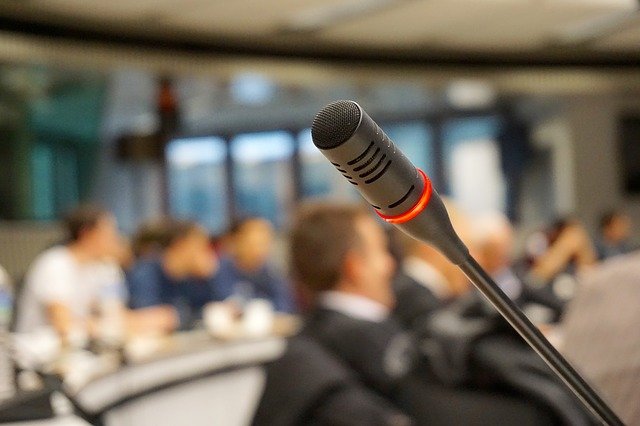4.7 – Good Beginnings: Writing Introductory Paragraphs
Learning Objectives
- Recognize the importance of strong introductory paragraphs.
- Learn to engage the reader immediately with the introductory paragraph.
Picture your introduction as a storefront window: You have a certain amount of space to attract your customers (readers) to your goods (subject) and bring them inside your store (discussion). Once you have enticed them with something intriguing, you then point them in a specific direction and try to make the sale (convince them to accept your thesis).
Your introduction is an invitation to your readers to consider what you have to say and then to follow your train of thought as you expand upon your thesis statement.
An introduction serves the following purposes:
- Establishes your voice and tone, or your attitude, toward the subject
- Introduces the general topic of the essay
- States the thesis that will be supported in the body paragraphs
First impressions are crucial and can leave lasting effects in your reader’s mind, which is why the introduction is so important to your essay. If your introductory paragraph is dull or disjointed, your reader probably will not have much interest in continuing with the essay.
Attracting Interest in Your Introductory Paragraph
Your introduction should begin with an engaging statement devised to provoke your readers’ interest. In the next few sentences, introduce them to your topic by stating general facts or ideas about the subject. As you move deeper into your introduction, you gradually narrow the focus, moving closer to your thesis. Moving smoothly and logically from your introductory remarks to your thesis statement can be achieved using a funnel technique , as illustrated in the diagram in Figure 1 – “Funnel Technique”.

Immediately capturing your readers’ interest increases the chances of having them read what you are about to discuss. You can garner curiosity for your essay in a number of ways. Try to get your readers personally involved by doing any of the following:
- Appealing to their emotions
- Using logic
- Beginning with a provocative question or opinion
- Opening with a startling statistic or surprising fact
- Raising a question or series of questions
- Presenting an explanation or rationalization for your essay
- Opening with a relevant quotation or incident
- Opening with a striking image
- Including a personal anecdote
Don’t forget to include an in-text citation and reference if you use anyone else’s ideas.
Capturing Attention
Capturing Attention (Text version)
Imagine you are writing an essay arguing for domesticated cats to be kept indoors. What follows are a list of potentially attention-grabbing first sentences for the introductory paragraph. Match the kind of appeal (a-i) in the list below to the sample sentence (1-9) that provides the best example.
Appeal
- Presenting an explanation or rationalization for your essay
- Opening with a relevant quotation or incident
- Including a personal anecdote
- Using logic
- Opening with a startling statistic or surprising fact
- Raising a question or series of questions
- Appealing to their emotions
- Opening with a striking image
- Beginning with a provocative question or opinion
Sample Sentences
- A little girl weeps at the untimely death of her beloved cat; an elderly neighbour misses the company of the neighbourhood songbirds.
- Most people love neighbourhood wildlife and most pet owners love their pets; a mutually beneficial strategy for keeping both safe is to keep cats indoors.
- Cats are cute, but they are also murderous killing machines bent on destroying your neighbourhood.
- Every year, cats kill between 100 million and 350 million birds in Canada alone; 38% of those birds are killed by domesticated cats.
- If you knew there was one single behavioural change that would improve your neighbourhood for generations, would you do it?
- The purpose of this essay is to protect neighbourhood wildlife from cats, and to protect cats from the hazards of this neighbourhood.
- “Curiosity killed the cat,” goes the famous adage.
- Imagine the sight of a beloved family cat who has been struck by a car on the highway.
- When I was a child, our family cat loved to roam free in the neighbourhood. I never wondered why there were no birds in our backyard, like my friends enjoyed and experienced.
Check your Answers: [1]
Activity Source: “Self-Practice 6.3 Capturing Attention” by Brenna Clark Gray (H5P Adaptation) is based on content from Writing for Success – 1st Canadian Edition by Tara Harkoff & [author removed], licensed under CC BY-NC-SA 4.0.
Tip
Remember that your diction, or word choice, while always important, is most crucial in your introductory paragraph. Boring diction could extinguish any desire a person might have to read through your discussion. Choose words that create images or express action.
In Narrowing the focus with Prewriting, you followed Mariah as she moved through the writing process. Now, Mariah incorporates some of the introductory elements into her introductory paragraph, which she previously outlined.
Mariah’s thesis statement, “Everyone wants the newest and best digital technology, but the choices are many and the specifications are often confusing”, is located at the end of the paragraph.
Reference
Li., E.A.L. (2014). Test for the real option in consumer behavior. Research in Economics, 68(1), 70–83. https://doi.org/10.1016/j.rie.2013.11.004
Tip
If you have trouble coming up with a provocative statement for your opening, it is a good idea to use a relevant, attention-grabbing quote about your topic. Use a search engine to find statements made by historical or significant figures about your subject. Don’t forget the in-text citation and reference for your source!
Writing at Work

In your job field, you may be required to write a speech for an event, such as an awards banquet or a dedication ceremony. The introduction of a speech is similar to an essay because you have a limited amount of space to attract your audience’s attention. Using the same techniques, such as a provocative quote or an interesting statistic, is an effective way to engage your listeners. Using the funnel approach also introduces your audience to your topic and then presents your main idea in a logical manner.
Mariah’s Strategies for Capturing Attention
Mariah’s Strategies for Capturing Attention (Plain text version)
Below you will see the text of Mariah’s introduction. Match the appropriate phrase in the introduction (1-4) to the attention-capturing strategy (a-d) used.
Introduction
- Play PlayStation games on a plasma TV? Maybe watch Disney movies on DVDs? Or read printed newspaper articles?
- Twenty-five years ago, the average college student did not have many options when it came to entertainment in the form of technology. Fast-forward to digital technology available today, and consumers are bombarded with endless options for how they do most everything- from buying and reading books to taking photos on their smartphones, to the point of being overwhelmed (Li, 2014).
- In a society that is obsessed with digital means of entertainment, it is easy for the average person to become baffled.
- Everyone wants the newest and best digital technology, but the choices are many and the specifications are often confusing.
Strategies
- Using logic
- Presenting an explanation or rationalization for your essay
- Raising a question or series of questions
- Opening with a startling statistic or surprising fact
Reference
Li., E.A.L. (2014). Test for the real option in consumer behavior. Research in Economics, 68(1), 70–83. https://doi.org/10.1016/j.rie.2013.11.004
Check your Answers:[2]
Activity Source: “Self-Practice 6.4 Identify Strategies to Capture Attention” by Brenna Clark Gray (H5P Adaptation) is based on content from Writing for Success – 1st Canadian Edition by Tara Harkoff & [author removed], licensed under CC BY-NC-SA 4.0.
Discussion Questions
Why do you think introductions are crucial in writing? What purpose do they serve, and how do they contribute to the overall impact of an essay or article?
what makes an introduction engaging for readers? Can you recall a piece of writing where the introduction particularly captured your attention? What elements stood out?
How much importance do you think readers place on the first few sentences of an essay? Discuss the concept of first impressions in writing and how they influence a reader’s perception of the entire piece.
Do you believe that the approach to introductions should vary based on the intended audience? How might the introduction to an academic essay differ from one in a magazine article or a blog post?
How do different authors introduce their messages?
- Look at dfferent examples
- Magazine Article: The Conversation: In-depth analysis, research, news and ideas from leading academics and researchers.
- Book Introduction: Introduction – A Guide for Successful Students (pressbooks.pub)
- Student Essay example: 7.1 – 5 Paragraph Research Essay – Development – COMM Ess (pressbooks.pub)
Tips for Good Beginnings:
Start Clear: Start with a clear and direct statement that gives a preview of what your essay will discuss.
Be Unique: Use original language and avoid overused phrases to make your introduction stand out.
Provide Relevant Background: Offer background information that directly supports your main points.
Provide your main idea early: Introduce your thesis statement (main idea) early on, ensuring the reader knows the main argument from the beginning. Your introduction should clearly reveal to your audience what to expect from the rest of your writing.
Show Confidence: Express your ideas with confidence. Avoid using apologetic or overly cautious language.
Maintain a Consistent Message: Ensure that your introduction aligns with the overall message and thesis of your essay.
Be Concise: Keep your introduction concise, avoiding unnecessary repetition.

Avoid Generalizations: Be specific in your statements and avoid making broad generalizations without supporting details.
Here are things to avoid:
Vagueness: Steer clear of vague statements that don’t provide a clear direction for your message.
Overused Phrases: Avoid clichés and overused expressions to maintain the originality of your introduction.
Excessive Background: Don’t overwhelm readers with too much background information. Stick to what’s directly relevant.
Delay in Thesis Presentation: Don’t wait too long to reveal your thesis or main idea. Provide a clear main point early in your introduction.
Apologies or Qualifiers: Skip apologizing or adding unnecessary qualifiers. Present your ideas confidently.
Avoid Conflicting Points: Double-check that your introduction doesn’t contradict the rest of your message.
Repetition: Don’t repeat yourself excessively in the introduction. Keep it concise and focused.
Key Takeaways
- A strong opening captures your readers’ interest and introduces them to your topic before you present your thesis statement.
- An introduction should restate your thesis, review your main points, and emphasize the importance of the topic.
- The funnel technique to writing the introduction begins with generalities and gradually narrows your focus until you present your thesis.
- A good introduction engages people’s emotions or logic, questions or explains the subject, or provides a striking image or quotation.
Attribution & References
Except where otherwise noted, this chapter (text & images) is adapted from “9.4 Writing introductory and concluding paragraphs” In Writing for Success by University of Minnesota licensed under CC BY-NC 4.0.


